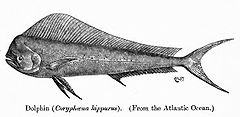Mahi-mahi
| Mahi-Mahi | |
|---|---|

| |
| Scientific classification | |
| Kingdom: | |
| Phylum: | |
| Class: | |
| Order: | |
| Family: | |
| Genus: | |
| Species: | C. hippurus
|
| Binomial name | |
| Coryphaena hippurus Linnaeus, 1758
| |
The Mahi-mahi, Coryphaena hippurus, also known as dolphin, common dolphin-fish, dorado maverikos, or lampuki (in Maltese) are surface-dwelling ray-finned fish found in off-shore tropical and subtropical waters worldwide. They are one of only two members of the Coryphaenidae family, the other being the Pompano dolphinfish. The name "mahi-mahi" ("strong-strong" in Hawaiian), particularly used on restaurant menus, has been adopted in recent years to avoid confusing these fish with dolphins, which are mammals.
General characteristics
Mahi-mahi have a lifespan of no more than three to four years. Catches average 7 to 13 kg (15 to 28 pounds). They seldom exceed 15 kg (33 pounds), and any Mahi-mahi over 18 kg (39 pounds) is exceptional. Mahi-mahi have compressed bodies and long dorsal fins extending almost the entire length of their bodies. Their anal fins are sharply concave. They are distinguished by dazzling colors: golden on the sides, bright blues and greens on the sides and back. Mature males also have prominent foreheads protruding well above the body proper. Females have a rounded head. The males and female have similar shaped bodies except for their heads. Females are usually smaller than the males.
When they are removed from the water, the fish often change between several colors (this being the reason for their name in Spanish Dorado Maverikos), finally fading to a muted yellow-grey upon death.
Mahi-mahi is one of the fastest-growing fish. They are fast swimmers as well, with a top swimming speed of 50 knots. Mahi-mahi spawn in warm ocean currents throughout much of the year, and its young are commonly found in sargassum weed.
Mahi-mahi are carnivorous, feeding on flying fish, crabs, squid, mackerel, and other small fish. They have also been known to eat zooplankton and crustaceans.

Capture
Mahi-mahi are highly sought for game fishing and commercial purposes. Game fishery is popular due to their beautŎ Mahi-mahi have become popular as a dish in many restaurants.

Location
Mahi-mahi can be found in the Caribbean Sea, on the west coast of North and South America, and Southeast Asia as well as many other places worldwide. The United States and the Caribbean countries are the primary consumers of Mahi-Mahi products.
Other developed countries in Europe are increasing their consumption every year.
Japan is a strong consumer as well.
The Arabian Sea is also great place to catch Mahi Mahi, particularly the coast of Oman. At first, most mahi-mahi were a by-catch (incidental catch) in the tuna/swordfish longline fishery. Now they are sought after by commercial fishermen off the Pacific Coast of Latin America, from Peru to Costa Rica. Recreational anglers also catch mahi-mahi offshore in the Atlantic Ocean from New Jersey to North Carolina.
Trivia
Mahi-mahi play a major role in the novel Life of Pi (they are called dorados).
Coincidentally, Mahi-mahi means "Fish fish" in Farsi.
References
- "Coryphaena hippurus". Integrated Taxonomic Information System. 11 March.
{{cite web}}: Check date values in:|date=and|year=/|date=mismatch (help) - Froese, Rainer; Pauly, Daniel (eds.) (2004). "Coryphaena hippurus" in FishBase. October 2004 version.
